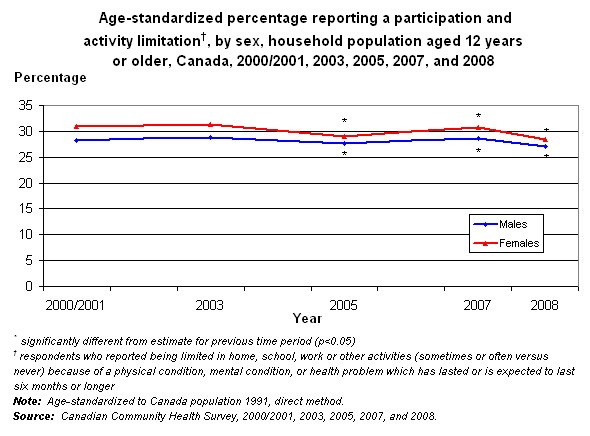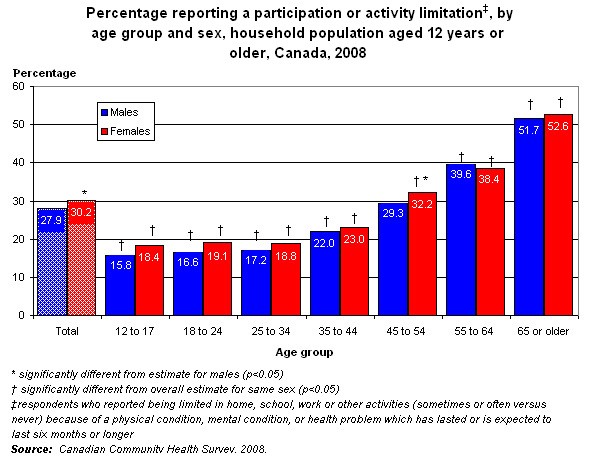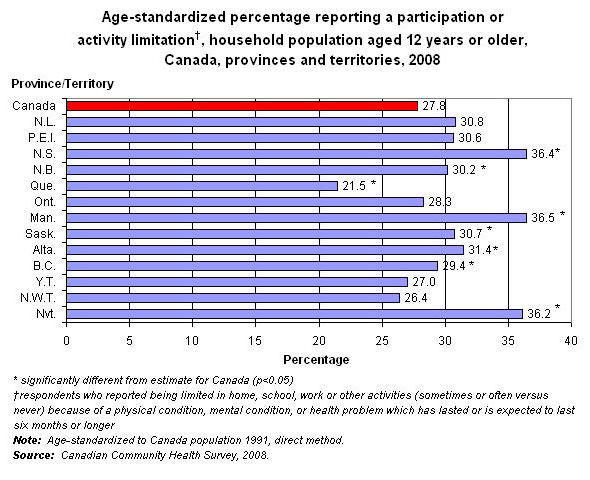Publications
Healthy people, healthy places
+Demographic change
+Health status
+Health behaviours
+Environment
Participation and activity limitation
Archived Content
Information identified as archived is provided for reference, research or recordkeeping purposes. It is not subject to the Government of Canada Web Standards and has not been altered or updated since it was archived. Please "contact us" to request a format other than those available.
This variable measures of the impact of long-term health conditions on the principal domains of life: home, work, school, and other activities.
It identifies respondents who experienced activity limitations imposed by a condition(s) or by long-term physical and/or mental health problem that has lasted or is expected to last 6 months or more. Those who reported such limitations "some of the time" or "all of the time" versus "never" were considered to have a participation and activity limitation.
This variable is not specific to a single health condition nor does it identify whether multiple conditions are present.
Importance of indicator
While it is imperative to measure the prevalence of specific health conditions, it is also important to understand the burden these conditions place on the daily lives of Canadians. The participation and activity limitation indicator helps to monitor this burden in the population.Background
- The ability to carry out daily activities without limitation is a determinant of perceived health. Changes in functional status can predict changes in health perceptions1.
- Functional status is associated with mortality. Seniors who reported an activity limitation had increased odds of dying over the next four years2.
- Canadians with arthritis were more likely to report participation and activity limitations than were people with other chronic conditions or those with no chronic conditions3.
- People with current or previous social anxiety disorder were more likely than those with no history of the disorder to report an activity limitation, even when potentially confounding effects of socio-economic characteristics (sex, age, marital status, education and income) were taken into account4.
- Activity limitations were more prevalent among people aged 45 to 64 with relatively little education or income5.
Highlights and graphs
Time trend

- The age-standardized percentage of Canadians age 12 or older who reported participation and activity limitations remained fairly stable between 2000/2001 and 2008.
- Females were consistently more likely than males to report participation and activity limitations.
Note: Age–standardized, direct method to 1991 Canada population.
Age group and sex

- In 2008, nearly 1 in 3 Canadians aged 12 or older (an estimated 3.9 million males and 4.3 million females) reported a long-term activity limitation due to a physical or mental health problem.
- The prevalence of participation and activity limitations rose with advancing age. Seniors were about three times more likely to report participation and activity limitations than were people aged 12 to 24.
- With the demographic shift to an older population in Canada, the number of seniors affected by these limitations will likely grow, even if proportion of seniors affected remains the same.
- Overall and at ages 45 to 54, females were slightly more likely than males to experience activity limitations. Among the other age groups, similar percentages of males and females reported activity limitations.
Province

- Residents of Nova Scotia, New Brunswick, Manitoba, Saskatchewan, Alberta, British Columbia and Nunavut were more likely to report participation and activity limitations than were Canadians overall.
- Quebec was the only province where residents were less likely than Canadians overall to report participation and activity limitations. Quebec residents were also less likely to report pain and arthritis than Canadians overall, which may contribute to their lower prevalence of activity limitation.
- Because the prevalence of activity limitations increases with advancing age, it is influenced by the age structure in a given province or territory. When age was not taken into account, residents of Newfoundland and Labrador and Prince Edward Island were more likely than Canadians overall to report participation and activity limitations. These differences were no longer significant when adjusting for age.
- Similarly, residents of Northwest Territories were less likely to report such limitations before age was accounted for, but not when age was controlled.
Note: Age–standardized, direct method to 1991 Canada population.
References
1. Shields M, Shooshtari S. Determinants of self-perceived health. Health Reports (Statistics Canada, Catalogue 82-003) 2001; 13(1):35-52.
2. Statistics Canada. Health among older adults. Health Reports (Statistics Canada, Catalogue 82-003) 1999a; 11(3):47-61.
3. Health Canada. Arthritis in Canada. An ongoing challenge. Ottawa: Health Canada 2003 (Cat. # H39-4/14-2003E).
4. Shields M. Social anxiety disorder: Beyond shyness. Health Reports (Statistics Canada, Catalogue82-003) 2004; 15 (Supplement):45-61.
5. Statistics Canada. Health in mid-life. Health Reports (Statistics Canada, Catalogue 82-003) 1999b; 11(3):35-46.)
Other studies
Kohen D, Uppal S, Guevremont A, Cartwright F. Children with disabilities and the educational system - a provincial perspective. Education Matters (Statistics Canada, Catalogue 81-004) Ottawa: 2007.
Statistics Canada. Participation and Activity Limitation Survey 2006: Families of Children with Disabilities in Canada (Catalogue 89-628 no. 009) Ottawa: 2008.
Statistics Canada. Participation and Activity Limitation Survey 2006: Labour Force Experience of People with Disabilities in Canada (Catalogue 89-628 no. 007) Ottawa: 2008.
Statistics Canada. Participation and Activity Limitation Survey 2006: A Profile of Education for Children with Disabilities in Canada (Catalogue 89-628 no. 004) Ottawa: 2008.
Statistics Canada. Participation and Activity Limitation Survey 2006: Analytical Report (Catalogue 89-628 no. 002) Ottawa: 2007.
- Date modified:
